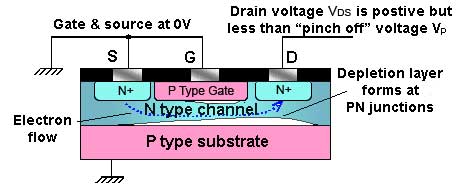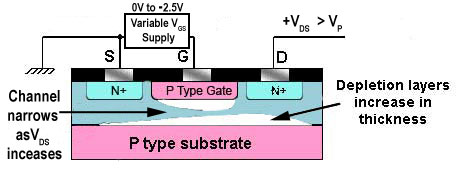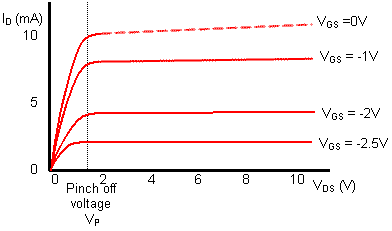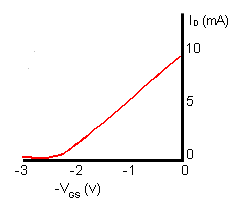The JFET Is A Voltage Operated Transistor
Fig 3.1.16a JFET Operation Below "Pinch Off"
In the N channel device, the N channel is sandwiched between two P type regions (the gate and the substrate). These regions are connected together to form the gate. The N type channel is connected via the more heavily doped N+ type drain to a positive supply. N+ type silicon is more heavily doped thatn N type. This gives it a lower resistivity, increasing conduction. It also reduces the effect of placing standard N type silicon next to the aluminium connector, which because aluminium is a tri-valent material and silicon has four valent electrons, would tend to create a junction, similar in effect to a PN junction at this point.
The P type gate is at 0V and is therefore negatively biased compared to the channel, which has a potential gradient on it as one end is connected to 0 volts n (the source) and the other to a positive voltage (the drain). Any point on the channel(apart from the extreme end near the source terminal) must therefore be more positve than the gate Therefore the two PN junctions formed between the N type channel and the P type areas of the gate and the substrate are both reverse biased; both junctions therefore have a depletion layer that extends into the channel as shown in Fig 3.1.16a.
The shape of the depletion layer is not symmetrical, as can be seen from fig 3.1.16a. It is generally thicker towards the drain end of the channel. This is because the voltage on the drain is more positive than that on the source, due to voltage gradient that exists along the channel. This causes a larger potential across the junctions nearer the drain, and hence a thickening of the depletion layer. This effect becomes more marked when the voltage between drain and source is greater than about 1volt or so.
Fig 3.1.16b JFET Operation Above "Pinch Off"

When a voltage is applied between drain and source (VDS) current flows. Now if VDS is increased (with VGS held steady) towards what is called the pinch off value VP, the drain current ID also at first, increases. The transistor is working in the mode shown in fig 3.1.16a.
However as drain source voltage VDS increases, the depletion layers at the gate junctions are also becoming thicker and so narrowing the N type channel available for conduction. There comes a point, known as "pinch off" where the depletion layers have almost met, as shown in fig 3.1.16b. At this point the voltage between drain and source is called the pinch off voltage VP and is a value generally a little higher than the voltage VGS between gate and source. Above this point there is little further increase in drain current. With the JFET biased in this way, a small change in VGS can be used to control the current through the source - drain channel.
This type of operation gives the fairly flat top to the output characteristics shown in fig 3.1.17a. Notice that each curve is drawn for a particular value of negative voltage between gate and source, and that when sufficient reverse bias is applied to the gate (e.g. more than -2.5V; the lowest value on the graph) the drain current ceases completely.
Fig 3.1.17a JFET Output Characteristic

In the JFET output characteristics shown in fig 3.1.17a, because the curves are very nearly horizontal at voltages greater than the pinch off voltage. This must mean that the there is little change in current for faily big changes in voltage, therefore the resistance of the JFET channel has become very high after pinch off.
Fig 3.1.17b JFET Transfer Characteristic

The transfer characteristic for a JFET, which shows the change in drain current for a given change in gate source voltage, is shown in fig 3.1.17b. Because the JFET is a voltage operated device we cannot talk of current gain as we do with bipolar transistors. The drain current is controlled by gate source voltage so the graph shows milliamperes per volt (mA/V). As I/V is CONDUCTANCE (the inverse of resistance V/I) we call the slope of this graph (the gain of the device) the FORWARD or MUTUAL TRANSCONDUCTANCE, which has the symbol gm. Thus the higher the value of gm the greater the amplification
Notice that VGS is always shown as being negative; in reality it may be zero or slightly above zero, but the gate is always more negative than the N type channel between source and drain. Note also that the slope of the curve in the transfer characteristic is less steep than that of the transfer characteristic for a typical bipolar transistor (compare figs 3.1.17b and 3.1.7). This means that a JFET will have a lower gain than that of a bipolar transistor.
This disadvantage is offset by the advantage of having an extremely high input resistance. A typical input resistance for a JFET would be in the region of 1 x 1010 ohms (10,000 Megohms!) compared with 2 to 3 Kohms for a bipolar device.
This makes the JFET ideal for applications where the circuit or device driving the JFET amplifier cannot supply any appreciable current, an example being the Electret microphone, which uses a FET within the microphone to amplify the tiny voltage variations appearing across the vibrating diaphragm element.
0 komentar:
Post a Comment